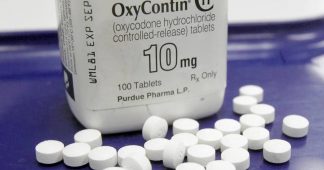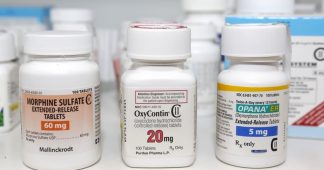By Amy Goodman & Denis Moynihan
March 28, 2019
Drug overdoses killed 700,000 people in the United States between 1999 and 2017, and more than two-thirds of those deaths were the result of opioids. This week, the state of Oklahoma won a landmark $270 million settlement against one of the world’s largest manufacturers of prescription opioids, Purdue Pharma, owned by the Sackler family. While the Sackler name doesn’t appear on Purdue’s pill bottles, it does adorn many prestigious museums and academic buildings around the world. Aggressive marketing of Purdue’s products, including its signature addictive drug, OxyContin, made billions of dollars for the Sacklers, some of which they gave to places like the Metropolitan Museum of Art and The Guggenheim Museum in New York, and the Tate museums in London. Now, the tide is turning, thanks in part to legal action like the one in Oklahoma — the lawsuits against Purdue and the Sacklers now number close to 2,000 — and creative protest campaigns at some of the museums that the Sacklers have funded.
Meanwhile, the opioid epidemic has continued to grow, expanding from prescription opioids like OxyContin to include heroin and now fentanyl. The epidemic knows no boundaries, affecting people across class and race lines. But, as the Centers for Disease Control and Prevention notes, two of the leading risk factors for becoming addicted to opioids, and potentially dying of an overdose, are living in a rural area and being poor. Native American reservations in the United States meet both criteria. It is no surprise that the opioid epidemic has hit indigenous populations especially hard.
“The number one disease that our people suffer from is anonymity or invisibility,” Stacy Bohlen, citizen of the Sault Ste. Marie Tribe of Chippewa Indians and CEO of the National Indian Health Board, said on the “Democracy Now!” news hour. “You’re looking at very vulnerable populations of people, very vulnerable health care systems, that are funded below 50 percent of need.” According to the CDC, drug overdoses among rural Native Americans and Native Alaskans, between 1999 and 2015, increased by 519 percent, more than twice the national average. That number itself is likely too low, as native people are often miscategorized ethnically or racially.
The Oglala Lakota Sioux Tribe in Pine Ridge, South Dakota, has filed a federal lawsuit against Purdue Pharma and several other opioid manufacturers. The devious and corrupt business practices detailed in the complaint are staggering, and reminiscent of the tactics used by the tobacco industry in order to deceive the public about the harms posed by cigarettes. The suit alleges Purdue and the other companies “intentionally flooded the market with opioids and pocketed billions of dollars in the process,” repeatedly making “false statements designed to persuade both doctors and patients that prescription opioids posed a low risk of addiction.”
“This threat to tribal communities across the United States, not just in South Dakota, is really an existential one … we’re talking about some of the most strained economies in the country, where you’ll see unemployment rates of 80 percent,” attorney Brendan Johnson, representing the Oglala Sioux, said on “Democracy Now!” “What is different here,” he added, “is that tribes do have a seat at the table, have been very aggressive in their claims, because oftentimes [with] the state and the state attorney generals, the tribal communities are forgotten. Here, that won’t be the case.”
As this case and close to 2,000 others make their way through the courts, people are taking action against Purdue Pharma. Artists and activists in New York City lined The Guggenheim Museum’s famous climbing spiral walkway, hurling into the vast atrium thousands of fake prescription pad pages bearing messages critical of the Sacklers. The action was inspired by a statement from the 1990s by Purdue co-owner Richard Sackler, that the launch of OxyContin would be “followed by a blizzard of prescriptions that would bury the competition.”
Artist Nan Goldin, one of the organizers of the protests, who herself had been addicted to OxyContin, tweeted, after details of the Oklahoma legal settlement were announced: “The Sackler family paid $75 million in the Oklahoma settlement today which admits their culpability. By the way, that’s only 0.2 percent of the $35 billion in profits they made from OxyContin.” To date, the Guggenheim and the Tate museums, as well as Britain’s National Portrait Gallery, have stopped accepting Sackler family funds, and other institutions are considering doing the same.
As the Sackler family name is stripped from elite art institutions, appearing more frequently in court proceedings, they must now answer for the ravages of the opioid epidemic from which they so handsomely profited. The anonymity they enjoyed, hiding behind Purdue Pharma, must end. But the anonymity of their victims must end as well: those who have died, and those who, addicted to opioids, still struggle to survive.
Published at https://www.democracynow.org/2019/3/28/the_opiod_epidemic_hits_hard_in











